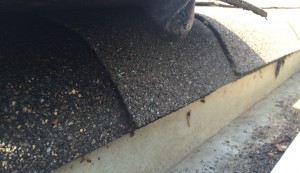What roofing shingle granules are and why they matter.
Granules on roofing shingles serve many purposes — they protect the asphalt layer in shingles from UV rays and weather elements, the granules add depth and colour to the appearance of a roof, they also add weight and fire resistance to the shingles.
Over time, all shingles start to lose their granules because as asphalt ages, its ‘sticky’ qualities deteriorate, and the granules have nothing holding them in place.
These ‘loose’ granules end up being carried away by storms and end up in gutters or on the driveway.
Actually, the first step in checking for granular loss is by inspecting these areas of one’s home.

Steps To Measuring Granule Loss:
First, place a gloved hand or ruler into your gutters to measure how much sediment is being deposited there.
If you feel lots of granules (i.e. your fingers make indentations in the sediment or your fingers are covered), then you might have premature granular loss, depending on the age of your roof.

Is your roof new?
If you have a new roof, it’s common to see some granule loss due to their loosening during the packaging, shipping or installation phases and these loose granules will be removed with the first storms and deposited in the gutters.
Otherwise, if your shingles are not newly installed, they have probably aged to the point where the asphalt is no longer ‘sticky’ enough to bond with its granular layer and it might be time for a roof inspection to determine how much ‘life’ they have left in them.
The next step in determining granule loss is to inspect your roof’s shingles closely.
Faded shingle colour is an early sign of roof damage and lets you know that it’s time to get your roof inspected.

Many ‘bald spots’ on the shingles and open blisters where the asphalt is visible is more worrisome because the UV rays can now get to the asphalt layer, which leads to faster shingle failure.
This is usually a sign that you need to get your roof replaced, unless the damage is limited to a smaller area that can be repaired.
While inspecting your own roof for granular loss, you must keep in mind that normal weather elements such as rain, wind, extreme temperatures, and even foot traffic on a roof can cause granule loss and you will always have some sediment in your gutters, so don’t panic!
Even though hail is (thankfully!) not that common to Kelowna’s weather, sometimes we are hit with a hail storm and that will cause major granular loss and heavy sediment in many Kelowna gutter systems.
If good quality shingles are on your roof, you will not have roof system failure after heavy storms, even though you might note a high level of granules in the gutters.
If the overall appearance of your shingles has not changed, or faded, there is more than enough granules in the shingles to withstand decades of weather damage.
Installing a quality shingle in the first place is extremely important because premature granular loss is especially seen in cheap shingles, where very little asphalt is used, like in the cheap Chinese knockoff shingles I discussed in my earlier article.
The less asphalt used, the lass ability the shingle has to bond with granules, leaving ‘bald’ spots exposed on a fairly new roof.
And cheap shingles will not use lots of asphalt — it’s the most expensive ingredient in shingles!
Therefore, beware of cheap material quotes by roofers, as many roofing companies will meet your budget while saving on the materials they use, often swapping for Chinese knock-off shingles that often look like the real thing.
The bottom line with granule loss is that a roof will always experience some loss, but that doesn’t mean it needs replacing!
It’s part of the normal aging process of a roof.
Archer Roofing can help you determine if you have normal or premature granule loss with an annual roof inspection.
Call us at (250) 808-6297.
